Mahoney Surname Ancestry ResultsOur indexes 1000-1999 include entries for the spelling 'mahoney'. In the period you have requested, we have the following 277 records (displaying 101 to 110): Single Surname Subscription | | | Buying all 277 results of this search individually would cost £1,760.00. But you can have free access to all 277 records for a year, to view, to save and print, for £100. Save £1,660.00. More... |
These sample scans are from the original record. You will get scans of the full pages or articles where the surname you searched for has been found. Your web browser may prevent the sample windows from opening; in this case please change your browser settings to allow pop-up windows from this site. Long-stay Paupers in Workhouses: Poplar Union
(1861)
This comprehensive return by the Poor Law Board for England and Wales in July 1861 revealed that of the 67,800 paupers aged 16 or over, exclusive of vagrants, then in the Board's workhouses, 14,216 (6,569 men, 7,647 women) had been inmates for a continuous period of five years and upwards. The return lists all these long-stay inmates from each of the 626 workhouses that had been existence for five years and more, giving full name; the amount of time that each had been in the workhouse (years and months); the reason assigned why the pauper in each case was unable to sustain himself or herself; and whether or not the pauper had been brought up in a district or workhouse school (very few had). The commonest reasons given for this long stay in the workhouse were: old age and infirm (3,331); infirm (2,565); idiot (1,565); weak mind (1,026); imbecile (997); and illness (493). MAHONEY. Cost: £6.00.  | Sample scan, click to enlarge

| Long-stay Paupers in Workhouses: St Leonard, Shoreditch, Parish
(1861)
This comprehensive return by the Poor Law Board for England and Wales in July 1861 revealed that of the 67,800 paupers aged 16 or over, exclusive of vagrants, then in the Board's workhouses, 14,216 (6,569 men, 7,647 women) had been inmates for a continuous period of five years and upwards. The return lists all these long-stay inmates from each of the 626 workhouses that had been existence for five years and more, giving full name; the amount of time that each had been in the workhouse (years and months); the reason assigned why the pauper in each case was unable to sustain himself or herself; and whether or not the pauper had been brought up in a district or workhouse school (very few had). The commonest reasons given for this long stay in the workhouse were: old age and infirm (3,331); infirm (2,565); idiot (1,565); weak mind (1,026); imbecile (997); and illness (493). MAHONEY. Cost: £6.00.  | Sample scan, click to enlarge

|  Men of the 57th Regiment who fought in the New Zealand War
(1860-1870) Men of the 57th Regiment who fought in the New Zealand War
(1860-1870)
New Zealand War Medal roll for the 57th (The West Middlesex) Regiment of Foot: for service in the New Zealand campaign 1863 to 1867: the rolls were compiled following a general order in 1869 and the medals were distributed in 1870. The regiment had been serving at Poonah in India, and was moved to New Zealand in November 1860; the men returned to England in April 1867.MAHONEY. Cost: £8.00.  | Sample scan, click to enlarge

|  Outstanding soldiers of the 103rd regiment of Foot
(1860-1870) Outstanding soldiers of the 103rd regiment of Foot
(1860-1870)
The 1st Bombay European Fusiliers were renamed the 103rd Regiment Royal Bombay Fusiliers in 1862. Each year just a handful of outstanding soldiers of the regiment were chosen for good conduct medals and gratuities: these are listed here. There were two lists, one for men recommended for the Good Conduct Medal without a gratuity, and one for gratuities - £5 to a private, £10 to a corporal, and £15 to a serjeant. Both lists are indexed here, and each gives rank, name, regimental number, date of recommendation and date of issue. (The sample scan is from the 105th foot)MAHONEY. Cost: £8.00.  | Sample scan, click to enlarge
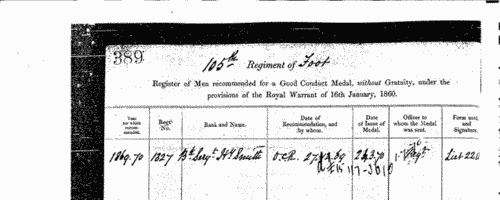
|  Outstanding soldiers of the 106th regiment of Foot
(1860-1870) Outstanding soldiers of the 106th regiment of Foot
(1860-1870)
The 2nd Bombay European Light Infantry was renamed the 106th (Bombay) Light Infantry in 1861. The regiment moved from Bombay to Neemuch in 1861; to Nusseerabad in 1864; to Meean Meer in 1867; to Umballa in 1868; and to Jhansi and Nowgong in 1870. Each year just a handful of outstanding soldiers of the regiment were chosen for good conduct medals and gratuities: these are listed here. There were two lists, one for men recommended for the Good Conduct Medal without a gratuity, and one for gratuities - £5 to a private, £10 to a corporal, and £15 to a serjeant. Both lists are indexed here, and each gives rank, name, regimental number, date of recommendation and date of issue. (The sample scan is from the 105th foot)MAHONEY. Cost: £8.00.  | Sample scan, click to enlarge
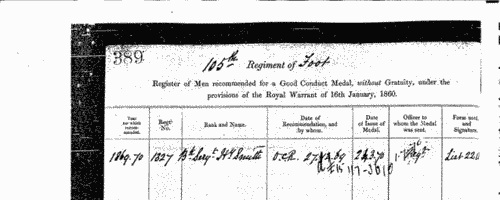
|  Outstanding soldiers of the 13th regiment of Hussars
(1860-1870) Outstanding soldiers of the 13th regiment of Hussars
(1860-1870)
The 13th Regiment of Light Dragoons or Hussars returned from the Crimea in 1856, embarked for Mauritius in 1857, and served in the East Indies. The home depot was at Edinburgh. Each year just a handful of outstanding soldiers of the regiment were chosen for good conduct medals and gratuities: these are listed here. There were two lists, one for men recommended for the Good Conduct Medal without a gratuity, and one for gratuities - £5 to a private, £10 to a corporal, and £15 to a serjeant. Both lists are indexed here, and each gives rank, name, regimental number, date of recommendation and date of issue. (The sample scan is from the 105th foot)MAHONEY. Cost: £8.00.  | Sample scan, click to enlarge
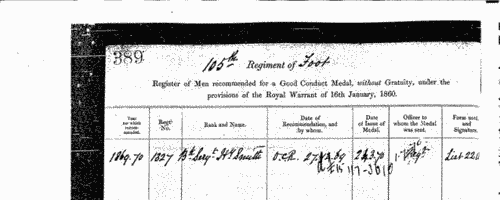
|  Outstanding soldiers of the 46th regiment of Foot
(1860-1870) Outstanding soldiers of the 46th regiment of Foot
(1860-1870)
The 46th (The South Devonshire) Regiment of Foot embarked for India in 1858, having fought in the Crimea. It was serving in the East Indies in 1860, and returned to England in 1869: the regimental depot was at Buttevant in Ireland. Each year just a handful of outstanding soldiers of the regiment were chosen for good conduct medals and gratuities: these are listed here. There were two lists, one for men recommended for the Good Conduct Medal without a gratuity, and one for gratuities - £5 to a private, £10 to a corporal, and £15 to a serjeant. Both lists are indexed here, and each gives rank, name, regimental number, date of recommendation and date of issue. (The sample scan is from the 105th foot)MAHONEY. Cost: £8.00.  | Sample scan, click to enlarge
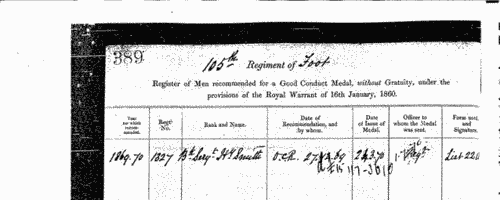
|  Outstanding soldiers of the 55th regiment of Foot
(1860-1870) Outstanding soldiers of the 55th regiment of Foot
(1860-1870)
The 55th (The Westmoreland) Regiment of Foot returned from Gibraltar in 1857, having fought in the Crimea. It was serving at the Curragh in 1860, and in that year was moved to England: the regimental depot was at Plymouth. In 1863 the regiment was sent to India. Each year just a handful of outstanding soldiers of the regiment were chosen for good conduct medals and gratuities: these are listed here. There were two lists, one for men recommended for the Good Conduct Medal without a gratuity, and one for gratuities - £5 to a private, £10 to a corporal, and £15 to a serjeant. Both lists are indexed here, and each gives rank, name, regimental number, date of recommendation and date of issue. (The sample scan is from the 105th foot)MAHONEY. Cost: £8.00.  | Sample scan, click to enlarge
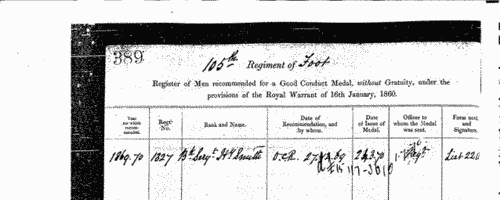
|  Outstanding soldiers of the 59th regiment of Foot
(1860-1870) Outstanding soldiers of the 59th regiment of Foot
(1860-1870)
The 59th (The 2nd Northamptonshire) Regiment of Foot embarked for Hong Kong in 1849. It was serving at the Cape of Good Hope by 1860. It returned to England and Scotland in 1861, and in 1865 to Ireland - the regimental depot was at Athlone - before being sent to Ceylon in 1867, and from there in 1869 to India. Each year just a handful of outstanding soldiers of the regiment were chosen for good conduct medals and gratuities: these are listed here. There were two lists, one for men recommended for the Good Conduct Medal without a gratuity, and one for gratuities - £5 to a private, £10 to a corporal, and £15 to a serjeant. Both lists are indexed here, and each gives rank, name, regimental number, date of recommendation and date of issue. (The sample scan is from the 105th foot)MAHONEY. Cost: £8.00.  | Sample scan, click to enlarge
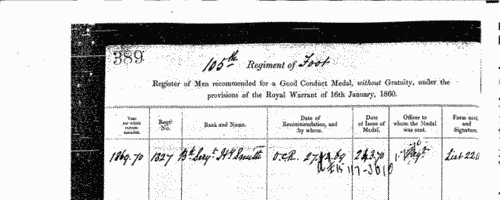
|  Outstanding soldiers of the 81st regiment of Foot
(1860-1870) Outstanding soldiers of the 81st regiment of Foot
(1860-1870)
The 81st Regiment of Foot (Loyal Lincoln Volunteers) embarked for India in 1853. It returned to England in 1865: the regimental depot was at Chatham. In 1867 the regiment was sent to Ireland, and from there in 1870 to Gibraltar. Each year just a handful of outstanding soldiers of the regiment were chosen for good conduct medals and gratuities: these are listed here. There were two lists, one for men recommended for the Good Conduct Medal without a gratuity, and one for gratuities - £5 to a private, £10 to a corporal, and £15 to a serjeant. Both lists are indexed here, and each gives rank, name, regimental number, date of recommendation and date of issue. (The sample scan is from the 105th foot)MAHONEY. Cost: £8.00.  | Sample scan, click to enlarge
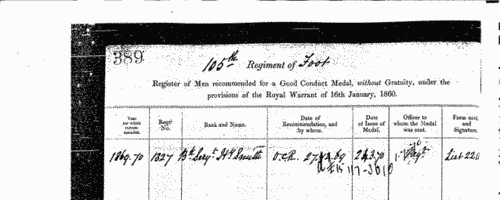
|
Research your ancestry, family history, genealogy and one-name study by direct access to original records and archives indexed by surname.
|













